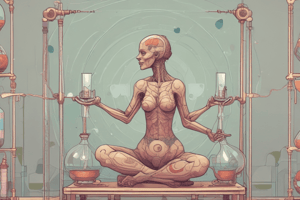Podcast
Questions and Answers
Why do cells use protein catalysts called enzymes to break covalent bonds?
Why do cells use protein catalysts called enzymes to break covalent bonds?
- To convert covalent bonds into ionic bonds
- To increase the temperature needed to break covalent bonds
- To decrease the temperature needed to break covalent bonds (correct)
- To prevent the formation of covalent bonds
What is a characteristic of non-polar covalent bonds?
What is a characteristic of non-polar covalent bonds?
- They involve atoms with different attraction to acquired electrons
- They only form in very high temperatures
- They form when shared atoms have similar attraction to acquired electrons (correct)
- They are weaker than ionic bonds
What type of bond forms when two atoms share electrons to fill their outermost energy level?
What type of bond forms when two atoms share electrons to fill their outermost energy level?
- Ionic bond
- Van der Waals bond
- Covalent bond (correct)
- Hydrogen bond
Why can some atoms, such as carbon, form long chains of atoms to create complex molecules?
Why can some atoms, such as carbon, form long chains of atoms to create complex molecules?
How do the hydrogen atoms in a water molecule contribute to its polarity?
How do the hydrogen atoms in a water molecule contribute to its polarity?
What is the defining characteristic of a polar molecule?
What is the defining characteristic of a polar molecule?
What type of bond forms when one of the poles of a water molecule is attracted to an opposite pole on another molecule?
What type of bond forms when one of the poles of a water molecule is attracted to an opposite pole on another molecule?
Why is hydrogen bonding considered important in biological molecules like DNA and proteins?
Why is hydrogen bonding considered important in biological molecules like DNA and proteins?
What are the three subatomic particles that make up an atom?
What are the three subatomic particles that make up an atom?
What is the relation between the number of protons and the number of electrons in a stable atom?
What is the relation between the number of protons and the number of electrons in a stable atom?
What distinguishes one element from another?
What distinguishes one element from another?
Where are protons and neutrons located within an atom?
Where are protons and neutrons located within an atom?




